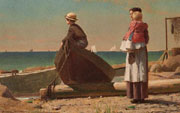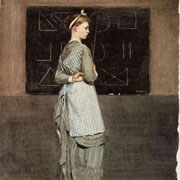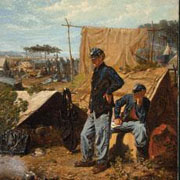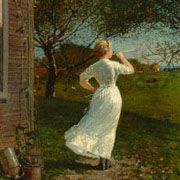-
(单词翻译:双击或拖选)
PEOPLE IN AMERICA - Winslow Homer, 1836-1910: America’s Painter
STEVE EMBER: I’m Steve Ember.
BARBARA KLEIN: And I’m Barbara Klein with PEOPLE IN AMERICA in VOA Special English. Today we tell about Winslow Homer, considered to be the greatest American artist of the nineteenth century. Homer created pictures that showed the relationship between humans and nature. The strong, clear images he drew and painted matched the wild, developing and proud United States of the late eighteen hundreds.
(MUSIC)
STEVE EMBER: Winslow Homer was the second of three sons of Henrietta Benson and Charles Savage1 Homer. He was born in Boston, Massachusetts in eighteen thirty-six and grew up in Cambridge. His father was an importer of tools and other goods. His mother was a painter. Winslow got his interest in drawing and painting from his mother. But his father also supported his son’s interest. Once, on a business trip to London, Charles Homer bought a set of drawing examples for his son to copy. Young Winslow used these to develop his early skill.
BARBARA KLEIN: Winslow’s older brother Charles went to Harvard University in Cambridge. The family expected Winslow would go, too. But, at the time, Harvard did not teach art. So Winslow’s father found him a job as an assistant in the trade of making and preparing pictures for printed media. At age nineteen, Winslow learned2 the process of lithography. This work was the only formal training that Winslow ever received in art.
 |
| This Winslow Homer painting from 1873 is called "Dad's Coming!" |
STEVE EMBER: Winslow did this work for about two years. Then the young man decided3 to become an independent illustrator, someone who makes drawings and pictures for a living.
He worked in Boston for a few years, drawing illustrations5 for stories in several newspapers. He also did work for a magazine that was different from any other of the time. Harper’s Weekly, in New York City, needed good illustrations and had lots of space for them. The young Winslow began to establish himself as an artist in demand.
BARBARA KLEIN: In eighteen fifty-nine, Winslow Homer moved to New York City to work for Harper’s Weekly. Homer also started to paint seriously. He hoped to go to Europe to study painting. But, something would intervene6 that would change the direction of Winslow Homer’s artistic7 work. Harper’s magazine would send him to draw pictures of the biggest event in American history since independence. It was the Civil War between the Union and the rebel8 southern states.
(MUSIC)
 |
| Homer Winslow's watercolor on wove paper "Blackboard" |
STEVE EMBER: Winslow Homer went to Washington, D.C., in eighteen sixty-one. He drew pictures of the campaign of Union Army General George McClellan the next year. His pictures of the war showed the many ways that conflicts affect people.
In one illustration4, he showed Union soldiers on horses advancing heroically9. The Southern Confederate soldiers are shown forced under the feet of the horses, while the horsemen hold their swords high. The illustration is called “The War for the Union, Eighteen Sixty-Two — A Cavalry10 Charge.”
BARBARA KLEIN: In another famous illustration, “The Army of the Potomac — A Sharp-Shooter on Picket11 Duty,” Homer showed a different side of war. A soldier sitting in a tree is holding a rifle12. He is aiming at a target far in the distance. Many critics say the picture shows the cold, mechanical13 nature of warfare14, bringing death to the unsuspecting.
Winslow Homer also made a famous painting called “Home, Sweet Home.” It shows two soldiers listening to music played by military musicians. This was common during the Civil War. At the end of the day, musicians on both sides would play to raise the spirits of soldiers. Often they would play the song “Home, Sweet Home.”
(MUSIC)
Homer painted two Union soldiers preparing a meal. The musicians are in the distance. The two soldiers appear to be stopped in the middle of their preparations by thoughts of home and family.
(MUSIC)
STEVE EMBER: Critics widely praised Homer’s work during the Civil War. His work gained him membership15 in what is now called the National Academy16. One painting, “Prisoners from the Front,” was chosen to represent the United States at the Exposition17 Universelle. This event was held in Paris, France in eighteen sixty-six. Homer went to Europe for the first time. However, little is known about his stay in Europe.
 |
| Often called the greatest American artist of the 1800s, here Winslow Homer's oil on canvas18 "Home, Sweet Home" |
BARBARA KLEIN: The next major change in Winslow Homer’s life was a decision to work in a new medium. Until now, Homer had used oil-based paints. Colorful substances are mixed with oil. These thick paints can be spread in layers, one over another, to produce interesting effects of light and color.
Oil paints are usually put on canvas cloth. Most people consider oil painting “serious painting.” But in the summer of eighteen seventy-three, Homer began using watercolor paint.
STEVE EMBER: Watercolor paint is color, or pigment19, dissolved in water. The paint is thin. Sometimes you can see through the paint to the paper underneath20. Watercolor paint can be used to color drawings or by itself. It is a much faster medium than oil painting. But it is a different and difficult skill to learn.
Homer’s decision to use watercolor may have been connected with another major decision. Two years after he started using watercolor, he stopped illustrating21 for magazines like Harper’s. In doing so, he ended a good way to earn a living. Instead, he decided to make a living only from selling his paintings. He was completely independent. Just as he said he always wanted to be.
BARBARA KLEIN: One of Homer’s best paintings from this period is called “Breezing Up.” It was shown for the first time in eighteen seventy-six. It shows three boys and a man in a small sailboat. A strong wind fills the sails. The man pulls in the sail, causing the boat to gain speed. One of the boys holds the rudder, which controls the direction of the boat. The two other younger boys hold on for the ride.
“Breezing Up” is considered one of Homer’s finest paintings. Today, it is part of the permanent collection of the National Gallery of Art in Washington, D.C.
(MUSIC)
STEVE EMBER: In the late eighteen seventies, experts say Homer experienced22 some kind of crisis23. Before, he had been a very social person. But after this period, he withdrew24 from social activities. Some critics say he had an unhappy relationship with a woman.
Whatever changed him, Homer must have felt a need to escape. He traveled to Britain in eighteen eighty-one. He spent most of his time in the fishing village of Cullercoats, near New Castle. There he painted many pictures of life and events on and near the sea.
BARBARA KLEIN: Homer returned to the United States the following year. He settled in Prouts Neck, Maine. He would call it home for the rest of his life. His brothers, Arthur and Charles, both owned houses there. It appeared that Homer withdrew from social life. He avoided visits from people wanting to meet America’s greatest living painter.
 |
| Winslow Homer's The Dinner Horn (Blowing the Horn at Seaside), 1870 |
But Homer’s later life was also filled with travel, which provided25 subjects for his paintings. He visited warm places – Bermuda, the Bahamas, Cuba and the American state of Florida. He made several trips to fish and to paint. In these places, he used bright watercolor paints.
STEVE EMBER: Homer also spent time in the Adirondack Mountains in New York State. There he found rich subject matter in the people, hunters and wildlife of the area. But now, a new subject became more important in his work. As he grew older, Homer increasingly26 painted subjects facing death.
One of Homer’s last paintings is called “Right and Left.” It shows two ducks that have just been shot by a hunter as they fly above the surface of a wide expanse of water. The painting is named for a hunter’s trick. It describes how a hunter can use both barrels27 of a shotgun to bring down two birds very quickly.
In the painting, the water and sky are grey. It is very early in the morning. If you look carefully at the painting, you can see two small points of the color orange. Looking closer still, you can see that one is a small part of a rising sun. The other is more surprising. It is the firing of the shotgun.
Almost hidden behind one of the falling ducks is the boat carrying the hunter. Here, Homer did something very unusual. The observer28 of the painting is directly in the line of gunfire.
BARBARA KLEIN: Winslow Homer died at Prouts Neck, Maine, in nineteen ten. He was firmly established as America’s greatest painter of the time.
(MUSIC)
STEVE EMBER: This program was written and produced by Mario Ritter. I’m Steve Ember.
BARBARA KLEIN: And I’m Barbara Klein. Join us again next week for PEOPLE IN AMERICA in VOA Special English.
 收听单词发音
收听单词发音
1
savage

|
|
| adj.野蛮的;凶恶的,残暴的;n.未开化的人 | |
参考例句: |
|
|
|
2
learned

|
|
| adj.有学问的,博学的;learn的过去式和过去分词 | |
参考例句: |
|
|
|
3
decided

|
|
| adj.决定了的,坚决的;明显的,明确的 | |
参考例句: |
|
|
|
4
illustration

|
|
| n.说明,例证;图解,插图 | |
参考例句: |
|
|
|
5
illustrations

|
|
| n.插图( illustration的名词复数 );图表;例证;说明 | |
参考例句: |
|
|
|
6
intervene

|
|
| vi.干涉,干预,干扰,阻挠 | |
参考例句: |
|
|
|
7
artistic

|
|
| adj.艺术(家)的,美术(家)的;善于艺术创作的 | |
参考例句: |
|
|
|
8
rebel

|
|
| n.叛徒,起义者;vi.造反,反抗,反感;adj.造反的,反抗的,反叛者的 | |
参考例句: |
|
|
|
9
heroically

|
|
| adv.英雄地;超人地;冒险地;庞大地 | |
参考例句: |
|
|
|
10
cavalry

|
|
| n.骑兵;轻装甲部队 | |
参考例句: |
|
|
|
11
picket

|
|
| n.纠察队;警戒哨;v.设置纠察线;布置警卫 | |
参考例句: |
|
|
|
12
rifle

|
|
| n.来复枪,步枪 | |
参考例句: |
|
|
|
13
mechanical

|
|
| adj.机械(学)的;力学的;机械似的;手工操作的 | |
参考例句: |
|
|
|
14
warfare

|
|
| n.战争(状态);斗争;冲突 | |
参考例句: |
|
|
|
15
membership

|
|
| n.成员资格,会员全体,从属关系 | |
参考例句: |
|
|
|
16
academy

|
|
| n.(高等)专科院校;学术社团,协会,研究院 | |
参考例句: |
|
|
|
17
exposition

|
|
| n.说明,讲解,展览(会),陈列 | |
参考例句: |
|
|
|
18
canvas

|
|
| n.粗帆布,一块油画布 | |
参考例句: |
|
|
|
19
pigment

|
|
| n.天然色素,干粉颜料 | |
参考例句: |
|
|
|
20
underneath

|
|
| adj.在...下面,在...底下;adv.在下面 | |
参考例句: |
|
|
|
21
illustrating

|
|
| 给…加插图( illustrate的现在分词 ); 说明; 表明; (用示例、图画等)说明 | |
参考例句: |
|
|
|
22
experienced

|
|
| adj.有经验的;经验丰富的,熟练的 | |
参考例句: |
|
|
|
23
crisis

|
|
| n.危机,危急关头,决定性时刻,关键阶段 | |
参考例句: |
|
|
|
24
withdrew

|
|
| v.取[收]回( withdraw的过去式 );(使)撤退[出];提;收回 | |
参考例句: |
|
|
|
25
provided

|
|
| conj.假如,若是;adj.预备好的,由...供给的 | |
参考例句: |
|
|
|
26
increasingly

|
|
| adv.逐渐地,日益地,逐渐增加地 | |
参考例句: |
|
|
|
27
barrels

|
|
| n.桶( barrel的名词复数 );枪[炮]管;一桶(的量);桶(石油计量单位,相当于120 到159 升) | |
参考例句: |
|
|
|
28
observer

|
|
| n.观察家,观察的人,观察员 | |
参考例句: |
|
|
|















